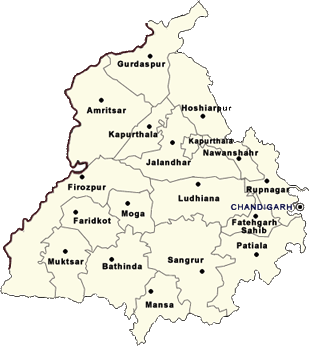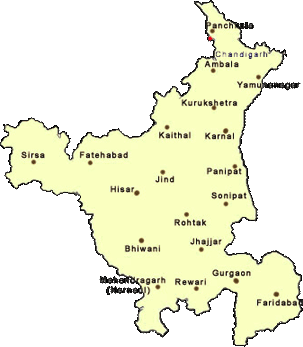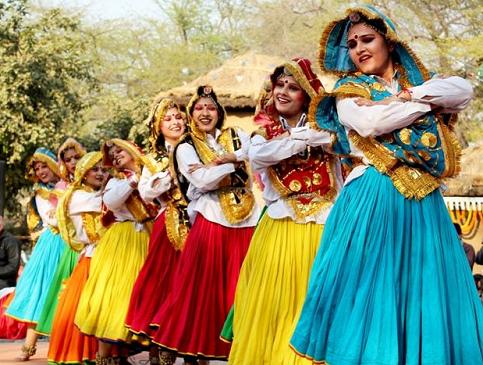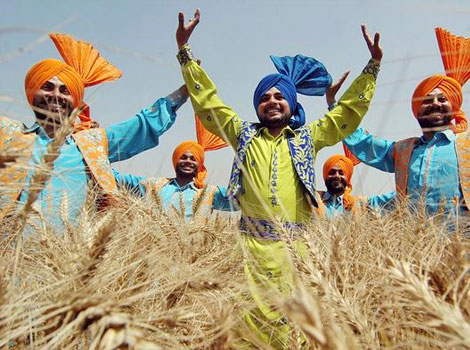|
|
|
Information about
Haryana and Punjab
|
|
Punjab, once, extended from Attock in the north-western part of India to Yamuna River in Delhi. The state of Punjab derives its name from five rivers that once flowed in Punjab. The five rivers of Punjab were Jhelum, Chenab, Ravi, Beas and Sutlej. Punjab is the homeland of the Sikhs, one of India’s most distinctive regional and religious groups. Haryana and Punjab are one of India’s most important agricultural regions. It is here that you can see the Indian tradition being played out in many aspects of daily life, festivals, building styles and house decoration, the regional handicrafts and the cuisine. The region has few truly great monuments. There are not many tourist attractions in Haryana, but, the Haryana Tourism has worked hard to appreciate travellers requirements and has developed an extensive chain of tourist complexes with lakes, restaurants, motels and shopping centres. In the last decade it has been difficult to travel around Punjab. Due to the continuous violence in the state, the permits are required to visit the state. Chandigarh is the capital of Punjab. Hindi, Punjabi and English are the main languages which are spoken here.
|
|
 |

|
|
|
|
|
History of
Haryana
and Punjab |
|
The land of Punjab was fertile which always attracted the invaders from Afghanistan and Central Asian Republics. It was on the banks of the Punjab rivers that ancient Hindu sages had sung the Vedic hymns and authored the Vedas. The Ghaggar Valley, running from the Siwaliks to the Rajasthan desert, was the home of fortified urban settlements before the rise of the Harappan civilization and go back before 3000 BC. It also had been a battleground for various years. In Panipat, in 1526, Babur defeated Ibraham Lodhi, the Sultan of Delhi, and founded the Mughal empire, Later, the Maathas who had succeeded the Mughals were defeated by the Afghan forces of Ahmed Shah Durrani. In Kurukshetra, the epic struggle between the Pandavas and Kauravas took place and Karnal is the site of a number of episodes in the Mahabharata, including that where Krishna is believed to have given Arjuna lessons in moral welfare. After 1700 BC, it came under the influence of Aryan invaders. The territory became the region in
which many of the fundamental beliefs and ideas of the Vedas took shape. Punjab was inhabited by Rajputs, the brave warriors of India. This region was incorporated into the Mauryan Empire during the 3rd century BC. Towards the middle of the 11th century, the Muslims were able to overcome the resistance of the Rajputs and Punjab came under their rule. The Mughals came to Punjab in the 16th century and took over the region and since then Punjab never rested in peace. The community of Sikhs began preaching the Hindu ascetic Nanak who lived in the Punjab from 1469 to 1539. Nanak taught that God is one and accessible to all and before his death chose one of his disciples to be his successor. He was followed by 9 Gurus. Aurangzeb tried to put down Sikhism by force, encouraging the Sikhs to become militant. Two centuries later, the Sikhs under Maharaja Ranjit Singh defeated the Mughals and took over the entire state to Afghanistan. In 1799 Ranjit Singh set up a sikh confederacy which governed until the late 1830. After the death of Ranjit Singh, the Sikhs were defeated by the British in 1846 and 1849 and this resulted in annexation of Punjab by the British. The Punjab which had supplied 60% of Indian troops in the First World War was hit economically in 1918. The feeling the British were not doing enough prompted demonstrations throughout the country and some of the most energetic were in the Punjab. Here, the Lieutenant governor and some of the provinces decided on a ‘fist force’ to repulse the essentially non-violent and vigorous demonstrations. They came under the control of General Dyer. The General Dyer ban all meetings but in spite of this thousands of pilgrims gathered in Amritsar in the Jallianwala Bagh on April 13, 1919 to celebrate Baisakhi, a holy day in the Sikh calendar. Dyer personally led some troops to the place, and simply ordered his men to open fire. About 379 people died and 1200 were wounded. During partition in 1947, the Muslim League demanded for a separate state for Muslims and Sikhs. In the event it was clear that the overwhelming majority of Sikhs would opt to be with India. The Redcliffe commission was set up to draw a boundary separating those districts with a Muslim majority from the remainder. The result was that the Punjab was divided into two, leaving as many as 5 million Sikhs and Hindus in the west Pakistan and as many Muslims in India. Many of these groups, terrified by the prospect of losing all that they had worked for, turned on each other in frenzied rage. During Partition, there was a movement of 11 million people across the new borders of India and Pakistan. In 1947, after the India's independence, Punjab were divided into two parts on the basis of the predominant religion in each district. The districts where Muslims were in majority went to Pakistan while those with Hindu and Sikh majority came to India. It was assumed that the people of both the religions would be allowed to stay where they were. But, it did not happen and the atmosphere became so tense that the movement of people took place in both directions. In the process, atrocities were committed on both sides of the border and at least a million people died. The Akalis, a dominant section of the Sikhs felt that they were losing their identity in the sea of Hindu majority and demanded a separate province where Sikhs would be in majority. In 1966, the Indian part of Punjab was once again divided and the Punjabi speaking areas were separated and the Hindi-speaking part of Punjab became Haryana. Hilly areas of Punjab like Kangra and Shimla went to Himachal Pradesh as these areas were non-Punjabi speaking. |
|
|
|
|
Geography of
Haryana
and Punjab |
|
Haryana covers an area of 44,222 square km and triangular in shape. It is bordered by Rajasthan and Punjab in the west and noth-west, Himachal Pradesh and Uttar Pradesh in the north and east and Delhi in the east. Apart from a small portion of the state which lies in the Siwalik Hills, the rest of the part lies on the Gangetic plain and is unrelentingly flat, lying at a height of between 220 to 270 m. The Yamuna river forms the eastern boundary of Haryana and its waters feed the extensive irrigation network. A number of small rivers, including the Ghaggar, flows in the south across it from the foothills of the Himalayas.
Punjab occupies a strategic position on India’s border with Pakistan on the west. It shares borders with Rajasthan and Haryana in the south, and Himachal Pradesh and Jammu & Kashmir in the north. The state covers an area of 50,362 square km. Nearly all of the Punjab is a gently sloping plain. There are three regions. The Siwalik Hills in the north-east varies in altitude from 275 m to 915 metres and occupy only a very small part of the state. Between the hills and the plain is a narrow transitional zone of gently undulating foothills, broken up in places by seasonal streams. Most of the state is on the low-lying well watered and highly fertile alluvial soils which make up the plains. There are one or two distinguishable upland areas between the main watercourse. The two major rivers are the Sutlej and the Beas which rise in the Himalaya. In the south-west, lies the sand dunes. |
|
|
|
|
Economy of
Haryana
and Punjab |
|
Agriculture is the main economic activity in Haryana and the state government has invested heavily in developing farming. The canal irrigation network has been increased and the rapid increase in the use of deep wells, has encouraged the rapid adoption of modern crop technologies. Now 91% of the total area is cultivated, with wheat, gram, barley and mustard grown in the rabi season and rice, millet, maize, sugarcane and cotton grown in the Kharif season. The state is also known for the quality of its bullocks and dairy cattle. Cotton and sugar processing have developed into important agro–industries. Haryana has no heavy industry but around Faridabad, a major light industrial zone has been established and it is the largest producer of automobile spare parts in India. Other products include paper, cement and bicycles. As a result of these developments in both agriculture and industry Haryana is one of India’s fastest growing states.
About 85% of the total area of Punjab is under cultivation and 70% of the population are engaged in agriculture. The state produces a surplus of food grains, mainly wheat and rice. The other main food grains are maize, gram, barley and pulses. Some of the major cash crops grown here are oilseeds, sugar cane, cotton and potatoes. Agricultural conditions have improved greatly in Punjab with the development of canal and tube well irrigation, and the promotion of modern crop technologies. Some of the important irrigation works implemented in Punjab include the Bhakra Nangal multi–purpose river valley project, the largest of its kind in Asia and the Madhopur-Beas and the Sutlej–Beas Links for the redistribution of water. The Green Revolution introduced in Punjab has turned it into the breadbasket of India. There are no mineral resources in Punjab. The industrial development is associated with agriculture and production of consumer goods. Bicycles and bicycle parts, sewing machines, machine tools, auto parts, electronic equipment, surgical goods, leather goods, hosiery, knitwear and textiles are manufactured in the state. Ludhiana accounts for 90% of the country’s woollen hosiery industry. Jalandhar is an important centre for the production of sports goods and Batala is known for its manufacture of agricultural implements.
|
|
|
|
|
Climate of
Haryana
and Punjab |
|
Punjab and Haryana have an inland continental climate. The winters are quite cold, where the temperatures ranges from 5 to 9 degree Celsius between November and February. Occasionally it reaches freezing point. Humidity at this time is usually low, but depressions moving in from the west sometimes bring rain and a chill dampness to the air. The summers are hot. In May and June the temperature ranges from 40 to 45 degree Celsius. Amritsar is situated near the border with Pakistan and receives 650 mm rainfall per annum, out of which 70% is received during the monsoon from July to September. The Shiwaliks receive the higher rainfall.
|
|
|
|
|
Flora & Fauna in
Haryana
and Punjab |
|
The tropical deciduous forests of Shisham, peepal, jujube, kikar were found in Shiwaliks but they are now covered in bush and scrub. The animal life is correspondingly rare and includes Nilgai, wild boar, rabbit, jackal, fox and various species of deer. The bird life is rich and includes heron, cranes and geese. Like Haryana, Punjab also receives migratory birds from the Northern hemisphere in the winter. Cobras, vipers and kraits are the poisonous snakes and are common in summer. |
|
|
|
|
People of
Haryana
and Punjab |
|
About 90% of the people in Haryana are Hindus and the majority of the people live in rural areas. There are no large cities in Haryana and various small towns have grown rapidly. Hindi is the main language which is spoken here. Urdu and Punjabi are spoken by Muslims and Sikhs. Various Hindu festivals are also celebrated in this region. The inhabitants of the Haryana and Punjab mainly descended from the Aryan tribes that invaded north-west India from around 1500 BC. Successive invaders became assimilated with the early Aryans. The Jats, Rajputs and Punjabis are a product of this movement of people. Two–thirds of the people in Punjab speak Punjabi, an Indo – Aryan language which is a close relative of Hindi. The rest of the people speak Hindi. Punjab is the homeland of the Sikhs and it is the only state where they form the majority. In dress, the Punjabi Salwar kamiz, a long kurta (shirt) and baggy trousers drawn in at the ankle are traditional and popular forms of dress with men and women alike. Women usually have a dupatta (long scarf or shawl) with it. The males have turbans and beard.
|

|
|
|
|
|
Culture of
Haryana
and Punjab |
|
The Punjabi culture is strongly influenced by Hinduism and Islam and also displays a distinctive character of its own. Its literature has strong connections with Sufism. Guru Nanak used the Punjabi language as a medium for poetic expression. The Sikh music is also popular like the Mughal ghazal and qawwali. Various people also believe that the Sikhs are endowed with an almost mystical affinity with machines. The Sikhs were among the first in India to use and understand various machines ranging from tractors to tube-wells, threshing machines to grinders. Sikhs are now found driving buses, taxis, hire cars and tanks. |
|
|
|
|
Festivals of
Haryana
and Punjab |
 |
Punjab and Haryana have always been known and identified as a land of celebrations. The festivals are celebrated with much fanfare and occasions for social gathering and enjoyment. Some of the festivals which are celebrated in Punjab and Haryana are
Baisakhi, Guruparb, Lohri, Holla Mohalla, Tika, Teej, Sanjhi and Gita
Jayanti. The Hindu festivals such as Dussehra and Diwali and the birth and death anniversaries of the gurus and saints are also also observed in the state. |
|
|
|
|
How to reach here |
|
The state of Punjab and Haryana are well served with roads and railways. The remotest parts of the state are incorporated into the road network, thus facilitating the collection and distribution of agriculture produce as well as promoting social mobility. Amritsar is well connected with Delhi and other North Indian centres. There is also a rail link with Pakistan which is 24 km to the west of
Amritsar. |
|
|